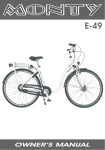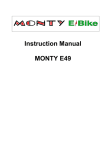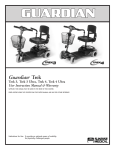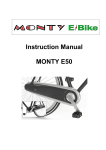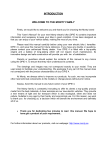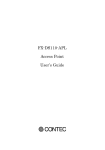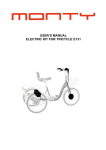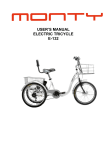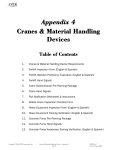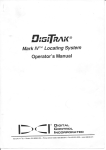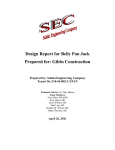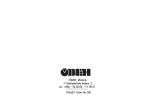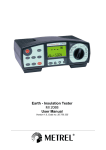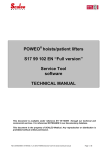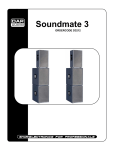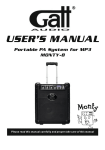Download E-48 USER`S MANUAL
Transcript
E-48 USER’S MANUAL 2 INTRODUCTION WELCOME TO THE MONTY FAMILY Firstly, we would like to welcome you and thank you for choosing the Monty brand This “User’s Manual” for your new Monty electric bike contains important information which you will need to keep your bike in good condition. It has been designed so that you can enjoy your E-Bike safely, making the most of your time. Please read this manual carefully before using your electric bike ( hereafter: E48),and save this manual for future reference. If you have any doubt or questions, please contact your authorized Monty dealer. The E-48 includes a long-lasting, top-quality engine which is not to require much maintenance from your side. Its innovative design and safe construction is to provide you with km and km of satisfaction. Parents or guardians should explain the contents of this manual to any minors using the E-Bike to ensure that they have understood its contents. The drawings and images may not correspond exactly to your model. They are used solely to facilitate your understanding. We apologize if any part of this manual does not correspond with the precise characteristics of your E-48. At Monty, we always strive to improve our products, as such, we may incorporate other new technical components to its models or change pieces without prior notice. Always give this manual to any future bicycle owner. The Monty family is constantly innovating to offer its clients a top-quality product made from the best materials. Our new E-Bikes are a clear example. They provide a new means of light and fun transport which is also ecological, silent and does not pollute. For this reason, we want to thank you for choosing us, a decision which will benefit the environment and all of us. Thank you as well for dedicating a few minutes to reading this manual. We hope that we have succeeded in making a product to you liking. For further information about our products, visit the Monty web site: http://www.monty.es 3 ATENTION: IMPORTANT WARNING NON-FULFILLMENT OF THE INSTRUCTIONS DETAILED IN THIS MANUAL MAY LEAD TO MECHANICAL FAILLURES, A LOSS OF CONTROL AND POSSIBLE FALLS, WITH SERIOUS PHYSICAL INJURIES TO THE USER OR OTHERS, INCLUDING EVEN DEATH. INCORRECT USAGE MAY ALSO RISK YOUR PHYSICAL INTEGRITY AND THAT OF OTHERS. SAFETY WARNING DO NOT OPEN OR MANIPULATE THE BATTERY, DOING SO WILL FORFEIT THE WARRANTY ESTABLISHED IN THIS MANUAL. IF YOU OPEN OR MANIPULATE THE BATTERY, CHARGER OR ELECTRICAL CIRCUIT, YOU MAY PROVOKE A SHORT-CIRCUIT AND POSSIBLE INJURIES ( SHOCK OR BURNS ). IT IS RECOMMENDED TO USE A HELMET WHILE RIDING. SAFETY WARNING DO NOT OPEN THE BATTERY NOR MANIPULITE IT, OTHERWISE, THE WARRANTY ARE TO BE ANNULED. MODIFYING THE TRANSMISSION, FORK OR ANY OTHER COMPONENT IMPLIES THE E-48 NO LONGER IS TO BE CONFORMED TO THE MONTY SPECIFICATIONS AND THEREBY ANNULS THE WARRANTY. MANIPULATING THE ELECTRIC BIKE’S ELECTRICAL COMPONENTS WILL ALSO FREE MONTY OF ANY POSSIBLE LIABILITY. SHOULD YOU HAVE ANY QUESTIONS OR DOUBTS, PLEASE CONTACT AN AUTHORIZED DEALER OR VISIT THE MONTY WEB SITE: http://www.monty.es CE (European Conform) 4 INDEX SECTION PÁG PRESENTATION....................................................................................................... IMPORTANT.................................................................................................. INDEX....................................................................................................................... 1. E-48 PARTS........................................................................................ 2. ICONS........................................................................... 3. GENERAL NORMS.................................................................................... 4. VEHICLE ASSEMBLING.............................................................................. 5. USER’S GUIDE.................................................................................... 5.1 How does the E-48 work ...................................................... 5.2 LCD display functions............................ 6. VERIFICATIONS............................................................................................. 7. ADVISES....................................................................................................... 8. SAFETY...................................................................................................... 9. MECHANICS AND MAINTENANCE................................................................ 9.1 Seat and Seat post............................................................................ 9.1.1 Seat position adjustment ............................... 9.1.2 How to adjust the seat position..................................... 9.2 Handlebar and Stem.......................................................................... 9.2.1 Conventional stem................................................................ 9.2.2 Ahead stem........................................................... 9.3 Fork and Headset........................................................................... 9.4 Suspension system: Forks.................................................. 9.5 Wheels........................................................................................................ 9.5.1 Tyre pressure chart............................................................ 9.6 Brakes......................................................................................................... 9.6.1 Rim brake system...................................... 9.6.2 mechanic disc brake ................................................. 9.7 Transmisión................................................................................................ 9.7.1 Rear derailleur checking............................................................ 9.8 Lights and Reflectors............................................................................. 10. BATTERY AND CHARGER.............................................................................. 10.1 The charger............................................................................................ 11. THE SYSTEM...................................................................................... 12. ACCESSORIES........................................................................................... 13. TECHNICAL CHARACTERISTICS .............................................................. 14. ADJUSTMENTS CHART....................................................................... 15. MAINTENANCE CHART.................................................................................. 16. SOLUTION CHART........................................................................ 17. GUARANTEE............................................................................................... 18. FREQUENT QUESTIONS............................................................................. 19. ELECTRIC SCHEME................................................................... 20. SPARE PARTS...................................................................................... 21. CLIENT FORM.................................................................................... 22. CONTACT AND DISTRIBUTORS................................................................. 3 4 5 6 6 7 7 8 9 11 13 14 15 17 17 17 19 20 20 21 23 24 24 26 26 27 29 30 31 34 35 35 38 39 40 41 42 43 45 46 47 48 49 49 5 1. E-48 PARTS 1 2 3 4 5 6 7 8 9 10 LCD DISPLAY SEAT STEM HANDLEBAR REAR CARRIER FRAME SEAT POST FRONT LIGHT REAR LIGHT REAR BRAKE 11 12 13 14 15 16 17 18 19 SEAT POST CLOSE FORK BATTERY ENGINE SHIFTING CONTROLLER CAGE PEDAL SENSORY PEDALS FRONT BRAKE 2. UNDERSTANDING ICONS The following icons are used throughout this manual. They will help you to understand it quicker and serve to point out important items. Go to another point Caution Advise Maintenance 6 3. GENERAL NORMS • • • • Please read this manual carefully before riding the Monty E-48. Ensure that the bike works correctly before riding. It is recommended not to change any of the E-48’s components and not to add any device which may interfere with them. Safety equipment must be used. 4. VEHICLE ASSEMBLING The vehicle assembling shall be done in a light, level and clean place with some basic mechanic knowledge,. or to get in touch with the official distributor or with Monty in order to solve any problem. • E-48 components: o E-48 principal assembled part o Front wheel o Front fenders o Pedals o Front light o Own manual o Contact keys o Charger • Required tools: o Allen o Spanner o Screwdriver o Nylon hammer • Assembling instructions 1. Take out all the components from the box and make sure to be all of them and remove the protector cartons from the E-48. 2. Place the front wheel to the bike 3. Fit the front fenders to the wheels 4. Assemble the stem to the stem 5. Fit the pedals to the cranks 6. Verification before the first use of the E-48 See section: MECHANIM AND MAINTENANCE for a right assembling. • Battery Charge 1. La battery must be charged on the whole before the first riding. See section: BATTERY AND CHARGE for a right charge. 7 5. USER’S GUIDE DESCRIPTION The E-48 is an electric bicycle with assisting pedal. A bicycle provided with an engine to help you. This helping engine is part of a system formed by the rear wheel, battery, controller and sensors, which performance is to very according to some conditions. The E-48 is provided with a control display placed on the handlebar to regulate the assisting help. The battery is charged by a charger connected to the electric system. The E-48 has a great autonomy which can ride to places where a conventional bicycle would be difficult to get along. TYPE OF USE FOR WHICH THIS BIKE HAS BEEN DESIGNED The Monty electric bicycles and their components are being designed as for normal bicycle use along the standard routes in good state and in good conditions. Incorrect usage other than the above or cross-county riding may lead to premature wear and tear, loose joints and/ or component breakage, thereby causing possible falls and/or injuries to the user. Ride only along the allowed routes set by the local rules. This vehicle is not recommended to children under the age of 14 years old. This vehicle is not recommended to people weighing more than 100 kg. 8 5.1 HOW THE E-48 WORKS Steps to follow: 1º Connect the electric system: Make sure the charger to be off. Turn the contact battery key to the position “(I)” (Figure handlebar power display (Figure 2). The handlebar 1) next push the button (1) LVD display is to light the screen and is to verify the size of the programmed wheel. In the screen, in a circulating way, the battery charge level, distance and speed are to be indicated. The E-48 is ready to perform. Figure 1. (Battery key) INFORMATION To stop the vehicle: Turn the battery key to counter clockwise, pushing, at the same time, the key towards inside to take the key out. To start: Turn the battery key to the clockwise Figure 2. ( screen) INFORMATION The LCD display has 4 buttons to be used as: 1- Power: To start or to stop 2- Set: selection of functions 3- Up-arrow: To get up selection 4- Down-arrow: To get selection down the the Verify the programmed wheel size to correspond to the assembled one. A wrong information can alter the speed and distance ones. 2º To initiate the riding of the vehicle To begin is necessary to pedal forwards and the engine is to start automatically. The engine is to go on while the pedals are turning as well. The PAR control system serves so that the engine power were proportional depending on the power applied to the pedals. (More power on the pedals = more power in the engine), (less power on the pedals = less power in the engine). 9 Remind to take out the bicycle rest before getting on the E-48. 3º How to stop or decrease the speed The assisting engine and the mechanical transmission are to be interrupted without pedalling and the brake levers shall be clamped to stop the E-48 and the assisting engine as well. 4º To stop the vehicle Once the route has been finished, the electric system must be stopped. First, the display must be off by pushing the power button battery must be disconnected with the contact key. . Once the screen is in White, the The battery charge level can also be verified directly by pressing the button placed in the superior face of the battery. ASSISTING WAYS: The E-48 is provided with a LCD display on the handlebar where all the information is recorded and serves also as a control panel to select the way more required to one necessities. With the display on position ON, the light display can be changed directly through the UP and DOWN arrows. There are 6 proportional assisting levels to the pedalling and 1 manual assisting way (auto). The proportional assisting levels works approximately as follow: level "1" : 35%-50% level "2" : 50%-60% level "3" : 60%-70% level "4" : 70%-80% level "5" : 75%-90% leve "6" : 85%-100% (Engine power ratio) The AUTO assisting way works with the power vary manual. See section: LCD DISPLAY FUNCTIONS Important: The brakes, for better safety, can stop the engine working if they are pressed Important: Check the section: VERIFICATIONS AND SAFETY before using the vehicle 10 5.2 LCD DISPLAY FUNCTIONS Functions: • Actual speed • Total distance • Partial distance • Time • Power level • Battery level • Assisting instructions • Break-down • Screen light • Wheel size selector Figure 3 1. The button (1) is the one to get on or to get out Press the button to show the km, actual speed, assisting way, battery level and the power level on the screen. Press the button again to get the system off. 2. The assisting way can be varied by the arrows. from the way to the first proportional one , to the second, etc. and vice versa. has three functions. 3. The button (2) 1. The display light works pushing the button while riding. The light goes off automatically at 5 seconds. When the light icon is in position intermittent, the light intensity can be varied by the UP and DOWN arrows in 5 levels. 2. If the button (2) is pressed two times the icon is let in intermittent position and the partial distance is shown. To get the indicator partial to Zero, press the DOWN arrow when it is shown in this indicator. 3. To select the wheel size the button must be pressed, continuously is let in intermittent position in the during 10 seconds. Then, the icon superior left side. Now, the size can be varied with the arrows. Once, it has been selected, press again the button to confirm. 4. The icon means that there is something wrong in the electric system. The intermittent code number is to inform where the problem proceeds. Remember this number for any technical asking. Some problems can be solved by only starting again the system or stopping and initiating the display and battery simultaneously. 5. 11 In case to initiate again the system, wait some seconds to get it cold Code “02” indicates that the controller has got off by a strong intensity. If this code persists once the system has been initiated again, some part of the internal system or the controller may have been damaged. Code “03” Indicates that some of the three cables have not worked for nearly 2 seconds. If the problem persists once the system has been initiated , this means some of the 3 connections are broken or loose. Code “04” Indicates the voltage to be under of the limits . Code “05” Indicates the problem coming from the brakes. This state must disappear if the brake can be unblocked. levers and the cable as well. Check the brake Code“06” Indicates that there is something wrong on the pedalling sensor. Code “07” Indicates a problem in the accelerator. It can be solved by initiating the system or the speed. Code “09” Indicates that a protection has been activated by a strong tension ( >53.5 V). The system is to stop. Code “08” Indicates an internal controller item has been damaged. The LCD display shows information distributor in following areas: Figura 4 1234567- the the Engine stem Actual speed Battery level The assisting way Distance and travelling time Light icons, break-down Km icons and special functions 6. VERIFICATIONS Verification before using the vehicle for the first time: The E-48 has been verified at the factory before being delivered , however, before using the vehicle for the first time, the following below parts should be checked: 12 • Correct position of the front and rear brakes: levers, V-brake, disc and cables. • Correct tight of the wheels nuts. • Correct pressure of the tires. • Correct wheels alignment. • Correct pedals fitting ( they shall be fitted strongly ). • Correct tight of the quick-release clamps The E-48 does not need any initial lubrication and it is prepared to travel the first km without any type of maintenance. Afterwards , the standard one The E-48 and its components must be checked before using the vehicle. Remember that in the case that a problem is detected that you can not fix, please contact with the authorized distributor Make as normal the following checking before riding the E-48. Verifications before riding the E-48: • WHEELS • • • • • • HANDLEBAR AND STEM HEADSET AND FORK SEAT & SEAT POST BRAKES TRANSMITION BATTERY AND CHARGER It is very important the brakes to work properly for one security and for the others. The brakes system must be verified before any route and the E-48 should not be used if a problem is detected. See section: MECHANICS AND MAINTENACE to solve the above mentioned problems. 7. ADVISES • Ride with care. See section. SAFETY. • Use the right gear • Not to exceed of the limit weight. No passenger is allowed on the E-48. • Plan your route according to the autonomy of the vehicle. • A programmer by the charger plug is to help in the charger task. • Protect the E-48 against thieves. Use a lock for more security. • Do not get on the E-48 with the rest displayed, this item is designed only to support the E-48 weight. • Keep the E-48 clean for a better performance of the vehicle. 13 • Do not watch the E-48 with any pressure water system. Avoid water entering into the bearings. Efficient pedalling : Get used to the right gear: The short gears (1,2,3) are for starting and on the slopes/ pending. The long gears (4,5,6,7) are for a quick ride and on the even routes. 8. SAFETY Important norms • • • • Respect the traffic lights Respect the traffic signs It is recommended to use helmet for one safety Keep on the one’s right side and pay special attention when motorized vehicles are present. Safety elements (Protection, visibility, circulation) Use a bicycle homologated helmet, right clothing with reflecting parts and not too much loose which could get hooked up to any part of the vehicle. Gloves and sport shoes also increase comfort and safety Local drive rules Be aware of all the local drive bicycle rules. Most countries have specific laws pertaining to bicycles and cycling. Contact local cycling clubs or the relevant Department of Transportation (or equivalent) for specific information regarding these laws. ( Check the Town House web site) Attention while riding One must be aware of any incident which may happen while riding such as, how avoid the potholes, the grids of the drains or edges which could help the wheels to skid. To avoid any obstacle, it should be in a transversal way with an angle of 90º, and if one it is not sure , get off of the vehicle. Riding with poor luminosity Be prudent on riding with poor light. The E-48 is provided with a light and reflector set. Keep them on. Use the front and rear light at any time required. It is convenient to bring striking and reflecting clothing, specially during the night . Take care with wet conditions The rain reduce the visibility and the grip as well. Ride with the low gears on the turns, on the zebra pass or sleepy areas in rain and wet conditions. Avoid riding on rainy days, days with heavy snowfall or through flooded areas.. Take care overtaking cars If a car comes on your way without indicating it or if someone opens the parked car door while you are overtaking the car, a serious problem could happen. Use the bell to make you noticed at any time required.. 14 Be cautious before a long route Remember to bring a kit for repairing a flat tyre, such as a tube, the required tools and a pump. It is advisable to bring a tool for everything and a first-aid kit, in case of a long route. Use the brakes with precaution Keep a moderate distance with the other vehicles and other objects. Calculate the brake capacity with the distance. To stop the vehicle grip both levers at the same time. The excessive use of the front wheel can provoke a skid on the front wheel, even the rear wheel may lost contact with the ground, making lost the control of the user and consequently a fall. Note: As with any other activity, the use of this vehicle implies certain risks. To get the E-48, such risk must be assumed by the user. In no case the dealer or manufacturer are to be liable. Avoid making unsafe actions while using the E-48 Many cyclist accidents could have been avoided if the common sense had been applied. - The hands always on the handlebar: any small imperfection of the road can provoke a vibration or a sudden turn on the front wheel. - Not to ride with object hanging from the handlebar or from any part of the frame, they could touch the spokes or provoke a sudden handlebar turn, causing the vehicle lost control. - Do not ride under the alcohol effects or under any medicament which can reduce the capacity of riding. The E-48 requires a good coordination of movements and the user shall be always with precaution of anything happening round him. - Never carry any additional passenger. The E-48 is designed to be ridden by one sole person. Resides, it is advisable not to increase the limit weight,. - Never ride with earphones as they reduce the ability to hear other vehicles. - Never hold oneself on another vehicle while riding. Important: Get the seat springs covered in case of fitting a kid seat in the rear. ATENTION: As any mechanical device, the E-48 is to wear down with different efforts. The different materials and components used may react differently to this daily decline. If the lasting life of a given component has been exceeded, it may suddenly break, injuring the user. The cracks, scratches or discoloration in the areas subject to intense use indicate that the component has exceeded its useful life and must therefore be replaced. Caution: In case of changing the cranks or tires, the distance between the wheel and the toes ( feet ) on turning may be reduced, thus putting at risk the cyclist’s safety. 15 Attention: In case of changing the cranks, pedals, tires, fork etc., the angle inclination can be reduced, thus putting at risk the cyclist’s safety 9. MECHANICS AND MAINTENANCE Many of the specific adjustments and general maintenance detailed in this manual can be done with Standard tools, which one may have at home. Nevertheless, we recommend to be carried out by a Monty official dealer who, in addition to the necessary expertise, will also have the tools needed for each item. 9.1 SEAT AND SEAT POST The height and position of the seat must be according to the right position of the user. A wrong position can provoke physical problems to the user. The seat must well be fitted to the seat post and the seat post to the frame well aligned. 9.1.1 SEAT POSITION ADJUSTMENT • The seat can be fitted in three parameters. 1. Seat height 2. Seat Inclination 3. Seat rear position 1. The seat’s height is the most important to be comfortable and be able to pedal safely and efficiently. This adjustment is based on the length of the cyclists leg. There are numerous specialized methods to choose the height depending on the length from the groin area to the base of the foot. It is recommend a simple way as follow: With the seat in a horizontal position, sit on the bike, ideally, it could be someone else holding the bike steady or use a nearby wall for support. With one of your heels, press down on either pedal, stretching the leg as much as possible. This is the correct height. (Figure 5) When riding, the leg should not be stretched out to the maximum when the pedal is in the lowest position. Figure 5 16 The seat adjustment is very personal See section: . To regulate the height, the seat post release" quick release must be open, later, the right height must be selected and close the quick release properly. The seat post height must be proportional to the rider’s height “ How to adjust the quick Never extend the seat post beyond the indicated line on the tube, as shown in point 1. See (Figure 6). Figura 6 2. Seat inclination. This adjustment is the most delicate and personal towards the user. Generally, it is horizontal or with the tip slanted slightly downwards. Try different positions until finding the most comfortable. This adjustment is made by loosing the screw (1) (allen 6 mm) underneath the seat, set the required inclination thigh the screw. The recommended torque value is (20-25 Newton). See (Figure 7). 3. Seat rear position: This seat adjustment implies moving the seat forwards or backwards with respect to the seat post. Generally, the seat is centred to the stem Placing the seat further back generally implies having to bend forward more to reach the handlebar and excessive strain on the quadriceps muscle group. To adjust this position, open the same bolt (1) (allen 6 mm) used to get the right inclination (Figure7). It is recommended to set at the same time: The inclination and the rear position. Figure 17 9.1.2 HOW TO ADJUST THE QUICK RELEASE Quick releases clamp systems do not need tools, they are frequently used for seat stems, axles and folding systems. The quick releases consists of two principal parts which must be adjusted a) The blocking lever which applies the force and. b) The nut to adjust the lever’s strength. For the proper and safe clamp adjustment, follow the following steps: 1. Turn the lever to the open position ( “open” is engraved on the lever ). See Figure 8 Figure 8 Figure 9 2. Choose the desired height while respecting the maximum indicated (Figure 6). 3. Turn the lever to close ( “Close is engraved on the lever”). (Figure 8) 4. If the lever is easily set to the “Close” position (less than 50 N (Newton ), this means that it is not tight enough, in this case, open again the lever to the “OPEN” (Figure 9) and tight the quick release again clockwise until noticing is well tight 5. Turn the lever to the “close” position. Once fastened in the right position (“Close” is engraved on the lever) Figure 8 6. If the force required to turn the lever were excessive (more than 200 N (Newton) repeat the previous step, turning the bold counter-clockwise. Do this as many times as necessary until safe The quick release must be positioned in a way that it does not interfere with other components and easy to be handled In case of doubts or if you can not set the adjustment, take E-48 to an authorized dealer or contact us 9.2 HANDLEBAR AND STEM The handlebar and stem must be fitted correctly at the suitable position of the user and well tightened. . 18 Check once a month to ensure that the stem is aligned with the front wheel. Also check the joint between the stem and handlebar, trying to move the latter with respect to the front wheel. Check as well no cables to be stretched or pinched when moving the handlebar. Verify all the screws and bolts to be tight. There are two kinds of stems • CONVENTIONAL STEM is the one to be inserted into the fork tube and the height can be regulated. The headset is provided with threads. • A-HEAD stem is the one to be fitted, externally, to the fork tube and not possibility to regulate the height. The headset is provided without threads 9.2.1 CONVENTIONAL STEM Adjustment of the handlebar height: A. Remove the rubber cap and loose the screw. Figure 1 in (Figure 10) counterclockwise (Allen 6mm). B. Move the handlebar sideways to unblock it and adjust to the designed height Caution: Never raise the stem above the line on the stem as indicated in point (1). See (Figure 11). Figure 10 Figure 11 C. Tighten the screw (1) clockwise until completely set. The recommended torque value for the stem: 20-30Nm. ( Newton ) Adjustment of the alignment: A. To set the handlebar perpendicular to the front wheel, use the same system like the height adjustment one. Move the handlebar sideways to unblock the handlebar and fit it to the required height Adjustment of the handlebar inclination: A. Loosen the screws (3) counter-clockwise as seen in (Figure 12). (Allen 6 mm.) 19 B. Chose the required inclination suitable to ones necessities. And verify the handlebar to be centred to the stem. C. Tighten the screws (3) clockwise . The recommended torque value is: 15Nm. ( Newton ) Figure 12 Adjustment of the stem inclination: A. Loosen the stem screw (2) counter-clockwise, indicated in the (Figure 12). (allen 6 mm.) B. Chose the inclination required. Take note of the indicated position since the handlebar inclination can be effected. C. Tighten the screw (2) clockwise. It is recommended torque value :17-20Nm. ( Newton ) Check the handlebar and stem for wear or stress signs. If you find any scratches, dents, warping, discoloration or cracks, remove the affected piece immediately. If you doubt whether or not the handlebar is safe to use, do not use the E-48. Take it to an authorized dealer 9.2.2 A-HEAD STEM Adjustment of the handlebar height: This kind of stem can not be regulated. Adjustment of the handlebar inclination: A. B. C. Loose the screws alternately counter clockwise (A) the ones which fix the handlebar to the stem (Figure 13). (Allen 6 mm.) Choose the required inclination suitable to ones necessities. Verify the handlebar to be centred to the stem. Tight the screws (A) clockwise. The recommended torque value of the handlebar : 15Nm. 20 Figure 13 Figure 14 Adjustment of the headset alignment: A. To place the handlebar perpendicular to the front wheel. Loose lightly the screw (B) and the screws (C) alternately. B. Move the handlebar sideway to unblock it and place it properly. C. First tighten the screw (B) to compress the headset forwards and backwards with the front brake, tighten the screw again (B) next tighten the screws (C) alternately to get a solid junction. Verify the headset adjustment. Adjustment of the stem inclination: A. Lose the screw counter clockwise (E) the ones to fix the stem, indicated in the (Figure 14). (allen 5 mm.) B. choose the required inclination most suitable to one’s necessity. Take note of the marked graduation (D). The handlebar inclination can be effected as well. C. Tighten the screw clockwise (E). The recommended value torque is:17-20 Nm. ( Newton ) See section: "FORK AND HEADSET" to get a headset and stem adjustment properly. 9.3 FORK AND HEADSET The headset includes all the bearings which allows the fork, stem and handlebar to turn. This section describes how to inspect, lubricate and adjust the fork and headset.. If the Bike is provided with a suspension fork, please see section referent to suspension forks. Inspection Inspect the headset and check to make sure that it is neither too tight nor loose. If either of these , in this situation do not use the E-48 and take it to the authorized dealer. 21 How to check the plays of the Headset Place oneself over the horizontal tube with both feet on the ground. Squeeze only the front brake while moving the vehicle forwards and backwards. Check if the headset is loose. The fork and stem can have a small play How to check the adjustment of the headset Place oneself over the horizontal tube with both feet on the ground. With the front wheel resting on the ground, turn the fork and stem to the left and to the right and vice versa. Feel if the headset is excessive tighten, in a way that it gets broken in some points by turning it Adjustment (only A-Head) If the Headset has a play or the fitting is not set properly, it must be tighten in the same way indicated. 9.2.2 A-HEAD STEM/ Adjustment of alignment. Caution: Adjusting the Headset requires special tools and expertise. It is recommended to check it with an authorized dealer. Attention: An incorrect headset adjusting may cause one to lose control of the bike and fall down. Ensure that the headset and stem to be correctly fitted before each use. LUBRICATION The Headset should be lubricated once a year. This requires specific know-how, expertise and special tools, for this reason only an authorized dealer should do it. 1 9.4 SUSPENSION SYSTEMS: FORKS The suspension forks allows the front wheel move , absorbing road irregularities and lessening the vibrations which the rider actually feels. The suspension forks need to be lubricated on a regular basis so that they work smoothly and their useful life be extended. This manual is a supplement to the maker fork information, If you have not received this information, one can unload it from the maker’s web site or get in touch with Monty INSPECTION Before riding the E-48, make sure that the suspension is working correctly. Do not use the bike if there is not enough distance between the fork and the Wheel. LUBRICATION Follow the instructions regarding lubrication and maintenance in the suspension manual. 9.5 WHEELS (mounting, rims, tires and tubes) 22 The wheels ( rims and tires ) are an extremely important part of the E-48. Check the right pressure of the tires and their condition and the rim as well. This is to depend on riding conditions, ground contact, the braking system and safety in general. One should periodically check to make sure that the wheels are securely held, that they are centred and do not buckle when moving. One should also ensure that the tires are properly inflated and that the thread is neither cracked nor worn down. The rim surface where the brakes make contact should be free of grease. Check the spokes not ot be broken or lose. The hubs should turn gently without moving side to side. Check it by moving the wheel sideways. Caution: A wheel in poor conditions may cause the user to lost control and a possible fall. Check the wheels each time before riding and do not use the bicycle until any possible problem had not been solved. Wheel mounting To mount the wheels, follow the following steps: 1. Mount the wheel to the fork ( front wheel and rear wheel ), ensuring that the axle is well placed in the fork groove. 2. Place the fixing nut 3. Tighten both nuts on either side of the axle by alternating and progressively tightening both in turns. 4. See the section: Torque value chart, for a right tight Check to ensure that the axles nuts are correctly placed as specified above. If they are not, readjust following the same steps or take the E-48 to an authorized dealer. Rear wheel The rear wheel holds the E-48 engine, and the engine cable comes out from one side of the axle, in case of a flat tyre or to change the tyre, the wheel can be moved partially and work on the contrary side of the axle. If you need to remove the Wheel completely, one must follow the cable to find out the connector. Normally the connector is found in the exterior side. Depending to some versions, the side cover underneath the battery to disconnect the engine cable. VERY IMPORTANT: Take note of the connections before disconnecting in order to connect them correctly later on. An incorrect connection may cause a severe problem. We recommend an authorized dealer to carry this work. Lubrication: The hubs must be lubricated on time per year. This operation requires some knowledge and special tools. We recommend an authorized dealer to do it. Caution: The rear Wheel has to be carefully mounted, ensuring that the motor cable comes out of the axle is not pinched or bent. The axle is provided of special washers to avoid the axle turning. Place them properly To remove wheels with a V-Brake system, the brake bridge has to be open first. Another option is to get the tyre flat. 23 Rims Information of the rim wear and associated risks. As the rim surface is part of the braking system, it is to be wear down. Using a bicycle with worn rims implies a serious risk for the user. For this reason, please pay special attention to this component. Some rims are engraved with a line to indicate the wear level of the rim. In this case, the user must ensure that the surface does not reach such a level, if it does, the rim must be changed. If you have any questions or doubts about the rims, contact n authorized dealer. The rims are provided with a warning icon such as that in figure 10.11 CAUTION: Excessive wear of the braking surface may cause a failure in the holding system and lead to injuries. Inspect the brake surface area for wear. Do not use rims that are severely worn. Figure 15 Tires The tires thread has to be in good condition and not to be worn, cracked or scratched. The thread pattern must be in good shape for a right traction. The tire’s measurements are printed on the lateral sides. Make sure when changing the t1yre to be compatible with the rim and bicycle. Caution: When replacing the tyre. Make sure that it is compatible with the rim and tyre of bicycle. E-bike tires have unique characteristics compared to standard tires. Tyre pressure Tires must be inflated to the right pressure to ensure the bike works properly. that is to say: - With a 4 kg (high ) tyre pressure, it is to achieve a greater speed though the riding is to be less comfortable and more nervous, with the added risk of falling on curves or slippery surfaces. - With a 2.5 kg. ( normal riding ) tyre pressure, greater comfort is achieved. You can adjust the tire pressure between 2.5 and 4 or even 4.5 kg to adapt to any requirement. The valve is like the “American” type as the ones used by the cars. However, it should be avoided filling the tires in the petrol stations, etc.. Use a pump with a suitable nozzle to the valve. To inflate the tyre, remove the valve cap and place the nozzle on the valve, ensuring that no air escapes. Check the pressure and place the cap back on the valve, ensuring air not to escape, verify the pressure and place the cap back on the valve to keep it from getting dirty. If the inner tube is flat, it is recommended to change it and not to fix it. Before riding your bike, check the tire pressure ( inflate the tires without exceeding the limit printed on the lateral sides of the tires ), the tires wear, the fitting and the alignment of the rims. 24 9.5.1 PRESSURE TABLE Wheel Front Rear Mínimum pressure Bar Kpa PSI 2,8 280 40 2,8 280 40 Maximum pressure Bar Kpa PSI 4,6 460 65 4,6 460 65 Recommended Bar Kpa PSI 3,0 300 42 3,5 350 50 9.6 BRAKES Ensure the brakes to work properly. They must perform and stop the bicycle within a safe distance. The engine should stop by squeezing either brake lever brake. Ensure the brake shoes / pads not to be excessively worn down. 00. It is extremely important the brakes to work correctly for one safety and for the others as well. Etc.. As any braking system, an incorrect adjustment, poor maintenance or a bad use of the brakes may cause to lose the control of the E-48 with all the consequences that this might imply. Never use the bike if the braking system is not working correctly or if you suspect any type of problem either with the brakes or their cables. If the E48 does not work properly, fix it or take it to an authorized dealer. Verify the brake system before using the E-48 and not use it if you detect any problem. Brake adjustment and working To brake or stop the E-48, the two brake levers must used properly, according to the circumstances and the engine is to stop automatically. The brake system is: Left lever to brake the front wheel and the right lever to brake the rear wheel. Brake system In the electric bicycles, the action of the brake levers no only act on the rims or disc, but on the engine as well, being disconnected at any time the brake lever is used. The E-48 models are provided with a rim and mechanical disc brake. The brake system allows one to slow down, being a critical function on the bike. This section describes how to inspect, adjust and lubricate the brakes of the E-48. Read the specific information about the exact type of the brake to assemble. Adjusting the braking system is difficult if one does not have the necessary know-how, experience and material. It is strongly recommended to make the brake adjustments by an authorized dealer. 9.6.1 RIM BRAKE SYSTEM In these types of brakes, the levers are connected by means of cables. By squeezing the brake lever, the shoes squeeze the rim, thereby slowing down the Wheel and the bicycle cables. 25 These systems consist of the following components: - Rim - Brake lever - Cables and casings - Brakes shoes/pads Never use this type of brake on the wheels designed for disc brakes. The rims require a flat surface for the brake shoes to work properly. Verification Before using the bicycle, squeeze the brake levers hard. The lever should never touch the handlebar. If it does so, the cable length will have to be adjusted as it described forwards. When the brakes are not being pressed ,the brake shoes should be at 1-2mm from the rim. The brake shoes must be aligned with the rim surface. If the brakes are to loose, tight or unaligned, adjust them before using the E-48. One should bear in mind the brake shoes ’angular alignment with respect to the rims to keep the brakes from grating. Used shoes and some new, V-type brakes may not require this alignment. Check the brake shoes , at least, once a month. They have small groves on their surface. If any of these are less than 1mm deep, they will have to be changed. If the original brake shoes do not have any grooves, they will have to be replaced when there were only 3 mm left of the rubber block with respect to the metal support. Setting the brake shoes vertically should be such that the rim’s edge were 1mm above the brake shoes edge. The brake shoes have to make contact with the rim perpendicularly to the brake surface as shown in . (Figure 16) The brake shoes must also be slightly tilted to the direction in which the wheel turns. Otherwise, the braking will be less effective and the braking is to make a lot of noise.. (Figure 17) Check the brake cables once a month to ensure that they are not bent or rusted and that there are no broken threads. Also check the coating to detect ant loose cables, bent ends, cuts and wear. Remove any defective cable or coating . The lever and brake shoes bolts should be tightened every three months. The V-brake type bolts must also be tightened every three months. Figure 16 Figure 17 AJUSTMENT How to adjust the distance between the brakes shoes and the rim To increase the distance between the brake shoes and the rim, turn the screw (Figure 18) clockwise and to reduce the distance, turn it counter-clockwise. If it is not possible to adjust the brake shoes as it is indicated above, loosen the cable bolt clamp and reattach the cable. 26 Figure 18 How to adjust the brake shoes alignment Loosen the brake shoes bolt. Follow the instructions above detailing how to inspect for the brake shoes alignment. Afterwards, squeeze the brake lever as hard as possible approximately 10 times. Ensure that the cable have not come loose, that the brake shoes are correctly aligned with respect to the rim and that the pads do not touch the tires. How to adjust the brake shoes alignment V-brakes type: Disconnect the joint tube and with a hand, squeeze firmly the brake shoes against the rim and from the other hand, pull the tub backwards from the joint and raise it up. Once disconnected, the tube is to come free. To closet he brakes, follow these same instructions in reverse order. Lubrication The brake lever pivots should be lubricated every 3 months with a synthetic lubricant, the same as it is used for the chains. When installing a new brake cable, it should be lubricated with a thin coat of synthetic lubricant. 9.6.2 MECHANICAL DISC BRAKES Instead of using a brake shoes to press on the wheel rim, a pad squeezes in a disc placed on the front wheel or rear wheel hub. The disc is fitted to the axle by means of bolts on the left side. The brake is activated by means of a cable connected to the brake lever. The braking system consist of the following: - Brake lever - Brake cable & casing - Brake disc pads CAUTION. The disc brakes may be very hot after using them. Be careful when inspecting them. As with other bicycle parts, avoid placing fingers inside the disc. Squeeze the brake levers 10 times before riding. The levers should not touch the handlebar. Ensure that there is no oil, grease or any other matter on the disc. The disc is part pf the braking system and should always be kept clean. Remove the pads from their supports for a deep cleaning. Do not use any cleaning products, degreasing liquids or solvents to clean the disc. Only use isopropyl alcohol. Ensure, once a month, the disc brakes not to be worn out. If the brake pads are less than 1 mm thick, they will have to be changed. Also, check the pads to be correctly positioned: A distance between 0.25 and 0.75 from the disc when not using the brakes. Turn the 27 wheel while not pressing the brake lever. The pads should touch the discs as little as possible. The brake cables should be checked once per month to ensure that they are not twisted or rusted, no broken threads or ends, and check their casing for cuts or wear. Change any defective piece. AJUSTMENT • How to adjust the separation between the pads and disc: Turn the pad’s adjustment screw. To increase the separation, turn it counter-clockwise and to reduce the distance, turn it clockwise. • How to align the brake to the disc: Loosen the brake mount bolts. Squeeze the lever completely and gradually tighten the bolts as it is indicated in the inspection section above. • How to remove the brake pads Remove the Wheel. With the fingers or a thin-nosed pliers, grab hold of the brake pad tab and pull.. • How to remove the wheel: With disc brakes, the braking system shall not to be removed. Carefully slide out the disc from the brake. When the wheel is to be fitted, carefully the disc must be guided between the pads. If the disc is pushed to the edge hard against the pads, they could be fractured or damaged . as a result they would have to be replaced. Important: The left brake lever corresponds to the front wheel and the right brake lever to the rear wheel. 9.7 TRANSMISSION The transmission must work properly. It has to be clean and lubricated, not to make noise and the gear mechanism must work smooth and exact.. All the links of the chain must pivot well and without noise. So, any link of the chain can be deformed. A correct transmission is crucial for a right working. Transmission set and adjustment. The E-Bike 48 transmission set carries power from the rear wheel by means of: Pedals, chain ring & cranks, chain and freewheel This section explains how to inspect, adjust and lubricate the transmission set. Pedals Inspect the pedals every three months. Check to make sure the pedal reflectors to be clean and correctly positioned. Make sure the pedals to be well fixed to the cranks. To check the pedals to work correctly, move the pedals up and down and left to right. If they are either too soft or rigid, take the E-48 to an authorized dealer to have them adjusted, lubricated or replaced. Cranks set and chain Inspect the crack set every three months, check to ensure the bolts joining them to be tight. Check the chain every three months for wear. Each complete link of the chain measures 25.4 mm. If twelve links in the chain measure more than 30.8cm, the chain should be 28 replaced or it is recommended to change it at the 1.500 km. Special tools and expertise are required to change the chain. Please take the E-48 to an authorized dealer. Adjustment The adjustment of the transmission set composed of freewheels, chain, chain wheel and pedals must be made by an authorized dealer since it is required specific tools and expertise. Lubrication and cleaning Clean and lubricate the chain and sprockets once a month. Avoid excess grease falling on the rest of the bike by placing a rag behind the chain. Once the chain has been lubricated, wipe off any excess grease with a rag. Do not use gasoline to clean the sprockets as it is highly inflammable and leaves a thin film of grease when it evaporates. Use a degreasing liquid and brush the sprockets to be clean. Caution: The left and right pedals are stamped to indicate what side they correspond to: “R” = right and “L” = left. Figure 19 Figure 20 9.7.1 Setting the rear derailleur The speed system changes the freewheel derailing the chain and moving it from one sprocket onto another.. Inspection The derailleur gear system is considered to be correct if its silent. If after every change a small temporary sound is heard, it may need to be adjusted. If it can not be adjusted and the sound increases, take the E-48 to the an authorized dealer. Check once a month the cables are not to be bent or rusted and check the cable not to have broken threads or deteriorated ends. The casings shall be verified as well to detect any lose cable, bent ends, cuts and wear. If there is a problem detected, no use the E.48, change the cable or take the E-48 to an authorized dealer. 29 Once a month check the shift lever to work properly. Every time a gear is changed, the sprocket should be moved in such a way that the chain is being moved smoothly and without jumps. The chain should never fall off of the internal or external sprocket. Adjustment The adjusting of the derailleur must be done with the bike firmly held on the work bench or with someone holding the rear wheel up in the air so that the transmission and the derailleur can work on a relaxed position. 17 How to adjust the derailleur The rear derailleur has two screws to regulate the limits, inner and outer, of the travelling which can be set in two different places , depending on the derailleur model. - Set the outer roller in line with the smallest sprocket, using the regulating outer screw (H). - Set the outer roller in line with the largest sprocket, using the regulating inner screw (L). To check it, try to pedal with all the possible freewheel options: - If, when in the intermediate positions, a noise is heard when changing the gears or the chain does not move to another sprocket smoothly, examine the cable tension ( set on the shift lever or in the same change ) to adjust it properly. - if the chain falls from the small sprocket, tighten the outer limit screw (H), a quarter turn. - if the chain does not fall from the small sprocket, loosen the outer limit screw (H), a quarter turn. - If the chain falls from the large sprocket towards the spokes, tighten the inner limit screw (L), a quarter turn. If the chain does not move up to the big sprocket, loosen the inner limit screw ( L), a quarter turn. If the sprocket system can not be lined up as it is explained above, take the E-48 to an authorized dealer. Figure 21 Figure 22 30 Figure 23 Figure 24 How to set the gear mechanism system To avoid any mechanical problem ( chain falling off, noise when pedalling, etc.) the below recommendations should be followed:: - Set the right speed changing just before the beginning of the climbing or to avoid any obstacle. - when one is going to change the gears, keep pedalling but without pushing the pedals excessively, using the shift lever till the chain is placed on the required sprocket - Avoid changing the gears while struggling to move uphill, for example, even if the synchronized systems allows to do so. In the E-48, the shift gear is necessary in order to get the maximum performance of the E48. This model is provided with a Shimano derailleur of 6 or 7 speed, to help the interaction between the rider and the vehicle. Las E-Bikes use a chain-based derailleur system. Changing the gears is done by using the right-hand shift lever or the left one depending on the model.. Chose the gear which offers the most comfort while riding. It is possible to change the gear while chain is moving forward. Never change the gear while the chain is still or moving backwards. Use the appropriate speeds before any change in the terrain. Continue pedalling gently while sifting the gears. 1 and 2 speeds for the starting and strong u-hill. 3 and 4 speeds for even surfaces or light up-hills. 5 and 6 for the descending and high speed. To change the gears, smooth the pedalling while you are using the shift lever, and without letting pedalling, change the gears one by one. Before stopping, change to the speed 1 or 2 2. Lubrication 31 The pivot points and the pulleys should be lubricated each month. Any cable which has been replaced should be greased in those areas where they are covered or where they are rubbed against another component. Chain tension The E-48 model is provided with a rear derailleur with a chain tensor. If the chain has the right length and the derailleur works correctly, the right chain tension should be maintained automatically. Lubrication It is very important to lubricate the vehicle components which do not generally require any maintenance, at least once a year, such as the hubs, gears, pedals and chain and as any new cable which may have been changed. Special oils should be used. Look for them in a specialized shop. See the maintenance chart. 9.8 LIGHTS AND REFLECTORS The reflectors reflex the light received from outside. While riding in the night or in conditions with poor visibility, or in the case that your vehicle is illuminated by another car, the reflector are to help to be seen. They are part important from the safety system and they should never be removed. Check the lights pointing in the right direction (perpendicular to the ground) and avoid any front and rear lights clean to work properly. Verify, every two months, the washers and item to cover them. It is important to keep the fix system to be well fastened. Check the local rules for the correct light system to be used on the public means. Verify the cables to be connected to the light device, the bulbs and all the system to work properly. If a problem is being detected get in touch an authorized dealer.. 32 10. LA BATTERY AND CHARGE The battery is the most important item of the E-48. A correct charge of the battery is extremely important to determine the battery’s life. The battery must be charged on the whole before using the vehicle. The battery is provided with a indicator to show when the battery is full charged. Make sure the ignition key to be blocked to avoid the vehicle move. The E-48 is equipped with a Lithium battery (LI) de 36 V 9 Ah. it consist of cells grouped together in series with an electronic control charge. It does not require any maintenance like the Lead-Acide ones(LA). It can be recharged at any time, thought, it is recommended not to get the battery discharged completely. Good use of the battery The first charge of the battery is very important to determinate the battery’s life. It must be complete (4/6 hours approx.) till the indicator shows to be full up. The lithium batteries are very sensitive while being charged. An inadequate power supply may damage the battery. In general, the batteries are also sensitive to extreme temperatures. Any manipulation of the battery by the user is to invalidate the warranty and free the manufacturer of any possible liability. The battery charge must be made in a dry and well-ventilated area. The batteries may discharge itself. It is normal to decrease the charge when the vehicle has not been used for a long time. It is recommended to make a complete discharge every three months, later, follow with a compete charge. 10.1 Charge The E-48 is provided with a charger of high power. Please follow the following steps: • • • • • The charges must be on position: ”off(O)”, stop (F) in (Figure 26) Connect the charger to the battery (B) in (Figure 25) Connect the charger to the electric system Set the charger switch to the position ,“on(I)”, start. Once the charge is finished, set the charger in position “(O)” and disconnect from the electric system. Figure 25 The battery can be charged on the vehicle while is still or be removed. If the battery is being removed, it must be handled with care. A supplied key is provided to unlock the battery’s safety latch. (A) in (Figure 25). 33 If the battery must be removed to be charged. Unlock the battery with the key and lift it up enough to take it out from the setting. When the charge is finished, place it again, making sure to be well placed by sliding the battery downwards and close the safety latch. Figure 26 Figure 27 Battery charge indicators Red light: the charger is connected to the electric system Yellow light: the battery is being charged Green light. The battery is charged or disconnected Battery fuse The battery is provided with a safety fuse of 10 A, in case that the charged dis not work, verify the fuse. (H) in (Figure 27), and change it, in case of being fused Indicators of the charge level The E-48 includes a battery charge indicator on the handlebar., (I) in (Figure 28). If the indicator light showed a line, while using the E-48, this would mean that the battery capacity is run out, in this case it should be charged at once. The battery includes an indicator which can be activated by a button. “lined” (B) in (Figure 29). Figure 28 Figure 29 34 Very important: Do not allow children to charge the battery. The electric charge (220 v), can cause serious personal injuries or even death. Do not charge the battery barefoot, on a damp or wet floor or in conditions which might threaten the one personal safety. The plug of the electric system must meet the pertinent safety conditions. Use the charger corresponding to E-48 model. Make the charging work in a well-ventilated area The manipulation of the battery by the user is to invalidate the warranty and free the manufacturer of any possible liability. The temperature may effect the battery to work properly. In general, the battery is to work well in high temperatures. When the temperature drops below 0 Cº, its performance can be reduced by a third of its power. For this reason, it is probable that the charge can last less time in winter. At 20 C, the battery shall work normally. When the temperature exceeds 35º-40º ( or if the battery has been exposed to the sun for a long time ) , the electric components may not work normally. Actions which may effect or reduce the battery performance. • • • • Constantly starting and stopping the E-48 as it can be in the cities Constantly braking and turning the bike on and off. Ride upwind or uphill and carrying extra weigh Low pressure tire and braked wheels. The above actions can influence the battery’s performance, reducing its life and the distance to be travelled being shorter. It is recommended to take well note of them to extend as much possible the distance which the E-48 can travel. CHARACTERISTICS Model Type Voltage Capacity Lifetime ( years ) Number of the chargers Charge time weigh E-48 Lithium (Li-ion) 36 V. 9 Ah. 2–4 600 Approx. 4-6 hours 2,3 Kg 35 11. PEDAL ASSIST SYSTEM Pedal assisted system (PAS) The pedal assists to a sensor which detects the move and power of the pedals when they are activated by the user. This system is set in the BB, transmitting the required information to the controller for its working. Controller The E-48 controller is the nerve centre of the system. It consists of a small box fitted under the battery compartment and where all the components are connected. The controller receives all the necessary information from the brakes, pedalling sensors (turns and pedalling force) , engine. battery, etc.., then it process to operate the E-48. The controller is responsible of the engine to work properly and the E-48 to be safe. Checking and handling the battery requires specific tools and know-how. Only an authorized dealer or the Monty plant should manipulate it. Engine The E-48 is provided with a top-quality and resistant engine. The engine is part of the rear wheel, designed to provide maximum service with barely any required maintenance. It can be either a brush or brushless type, depending on the its version. The engine, as part of the rear wheel must be well fixed as it is explained in the section: Wheels. Otherwise, there is a risk of a serious problem. Be specially careful with the cable coming from the axle. Have special attention with the engine cable not to bend or damage it in any way. Important: Avoid heavy hits to the wheel or damage the rim as the engine could be damaged as well. It is recommended to check it , once per year, to ensure to work correctly. 36 12. ACCESSORIES To improve the E-bike components, many of them are provided with different types of accessories. Such as lights to improve the visibility of the user, racks or bells. All the accessories must be in good conditions to ensure their optimal performance. REVISION The screws and bolts should be inspected once a month. The right torque value for the fender bolts is. 3.5-4.5Nm ( Newton ) and the bolts from the junction between the fenders and the frame is 6-7Nm. ( Newton ) LIGHT SET The light set has been designed to increase the safety of the user in conditions with a poor visibility as it can be while riding at night or in the fog. The lights are being powered by the E-48 battery’s. Once connected , ensure that they light up and point in the right direction to obtain the optimal combination of shine and brightness suited to one’s requirement. The light set must be always kept clean. Remember that the vision can be reduced at night, therefore, it is recommended to show down and adapt the riding to the required situation. At night, even the lights are on, the visibility is less than during the day. In addition, it is recommend to change the bulb set every six months because there is not any warning system to detect it if they are broken and one may run the risk of not having any light when you need the most Avoid overstretching or cutting the cables. If this happens, the lights are to get off. If the battery is discharged on the whole, the light system will let to function so , be sure the battery to be well charged and bring a fuse as spare parts. Peligro INSTALLATION In case that the vehicle is not provided with a light set, it is recommended to visit an authorized dealer. To change the bulbs, make sure of the original bulb’s voltage and power. In case of any doubt, contact and authorized dealer. HOW TO INSTALL A BULB Locate and unscrew the bolt or the system to move the covering of the front and rear light .Remove the bulb set in a way that the bulb can be taken out. Take care of not breaking the bulb while taking it out. Place the new bulb and follow the same instructions in reverse order to finish it. LEDS The leds have less consumption and last more time than the standard ones, however, the change is not so easy as the bulbs. When a leds light is disconnected, take in mind that the polarity can not be changed . It is necessary to respect the same polarity. Importance of the use of original parts 37 It is extremely important to use always original parts when replacing E-48 components. Not doing so, it may invalidate the manufacture’s warranty. Current Law According to the following regulations: • • • • • EN 14764 ISO 5775-1 y ISO 5775-2 PREN 14872 ISO 9633 ISO 7636 13. TEHCNICAL CHARACTERISTICS Note: The following characteristics may be subject to change without any prior notice. The E-48 is not recommended for those weighing more than 100 kg E-BIKE Engine Battery Voltage Max. speed Autonomy Charge time Frame time Fork Stem Gears Brakes Wheels Pedals Weight User max. weight Luggage max. weight Max.load Equipment E-48 250 W Brushless in the rear wheel Lithium 36 V-9 Ah 36 V 25 Km/h 35-40 Max. 4-6 h Aluminium Suspension 1 1/8 Adjustable 7 speeds Disc / V-Brake 26” Aluminium Aluminium 27,4 kgs 100 kg. 15 kg User+ luggage ( 115 kg) Display LCD, Lights, Carrier, Resting, stem selector and bell. 38 14. TORQUE VALUE CHART Component wheels Cranks Brake shoes item Quick releases Front nut Rear nut Fixing bolt Quick release Bolt Hight bolt Inclination bolt Handlebar bolt Fixing bolt Adjusting bolt Handlebar bolt Cranck nut Alignment 20-25 Nm 20-30 Nm 17-20 Nm 15 Nm 12-15 Nm 10-14 Nm 12-15 Nm 15-20 Nm 8-10Nm Brake Brake bolt 8-10Nm Brake lever clamp Brake shoes mount bolts Adapter mount bolts: Fixing screw 6-8Nm 11.5-12.5Nm Seat Seat post Standard stem Ahead stem Torque value Force 100 N* 20-25 Nm 30-35 Nm 20-25 Nm 100 N* 11.5-12.5Nm Disc mount bolts 5-6Nm Cable clamp bolts Fenders 6-8Nm 3.5-4.5Nm Support bolts Junction bolts between the alignment bolts and the frame 6-7Nm. *Force: 9,8N = 1kgf (1) Tight value: A par corresponds to the force applied with a lever arm. Its unity is Nm (Newton per meter). 10 N corresponds to the force which makes 1 kg with the gravity. 39 15. MAINTENANCE CHART This chart reflects maximum values and can vary depending on the use given to the bike and the wear resulting from the different riding of the users. It can also vary depending on the terrain, weather and riding stile, etc. Component Seat post Handlebar/ Wheel alignment Hubs Lights / reflectors Fork / Headset Pedals Chain wheel Chain Cables Gears Brake shoes Brake lever screws Brake V-brake pívot bolts Brake levers Disc brakes Bulbs Inspection 1 month 1 month Lubrication 1 year 2 months 1 month 3 months 3 months 3 months 1 month 1 month 1 month 1 month 1 month 1 year 1 month 1 month 1 month replacement 1 year 1 year 1500 Km 6 months 1 year No partten shown 3 months 3 months 3 months 6 months 40 16.SOLUTIONS CHART INCIDENCE 1º 2º 3º Alter setting the battery to charge, it seems not to charge When turning the battery key, the charge indicator does not light up The engine does not start when pedalling POSSIBLE CAUSE 1. The charger is not connected properly 1. Adjust the connections to ensure good connection 2. The battery is not in the charge position 2. 3. The charger does not work properly 3. Check the batter position to be right ( ON/OFF) according to the model Check the charger light to be on without being interrupted. Contact to the technical service in case it did not blink 4. the charger fuse is fused 4. The fuse must be changed 1. Check the battery indicator and recharge if it were necessary 2. verify the fuse and replace it ( See the technical service section ) 3. verify the connections and contact a technical service if it were necessary 1. The battery is discharged on the whole 2. The fuse is out or it is not well connected 3. the key switch does not work 1. the battery has not been connected 1. make sure the battery to be on position ON 2. The brakes are in function 2. 3. The Pedal assisting is not connected. 3. 4. The pedal assisting does not receive any sign from the pedal The engine is stopped by using the brake lever, make sure not to press the brake lever on starting the vehicle.. Some models have the possibility to disconnect the Assisting pedalling by and a Red switch set just under the battery. Make sure not to be connected. 5. 4º The engine is stopped alter having moved just a few meters or when climbing a not very steep hill SOLUTION In models with a sensor (magnetic) transmission, ensure that it is correctly positioned, just at few millimeter separating it from the magnetic support found at the same height as the left connecting rod. 5. check the fuse and the electric connections. See the relevant section. 1. Ensure the pedalling to be properly. The engine is to be activated on receiving the pedal working. If the pedalling goes slowly or interrupted by the brakes , the engine is to stopped Make sure the battery to be connected correctly it must be a faulty electric item 1. The engine has not received the pedalling force 2. The cable has been detached from the battery 3. 4. The sensor is out of place 2. 3. Check the position of the sensor to be right. 41 5º The engine gets stopped or Works irregularly after having been used for a long time or during long uphill climbs 4. The fuse is out 4. Check the fuse and change it if it were necessary ( see the relevant section ) 1. Engine overheated 1. 2. the fuse is out 3. The battery is discharged Intensive and continuous use of the bike at maximum power may overheat the engine and its controller as well. In this case, wait a few minutes to let them cool down. Check the fuse. See the relevant section Check the charge of the battery . The amount consumed may be different depending on the external riding conditions. Check the electric connections. See the relevant section. 2. 4. there is an electric malfunction 3. 4. 6º 7º 8º The battery has not enough autonomy A strange noise can be hear from the front wheel (engine) The brakes make noise or /they do not work brake very well 1. The battery can not be charged properly 2. The battery is not charging correctly 1. the wheel may not be correctly aligned 2. The spokes of the wheel can be loose 1. The battery has to e in top conditions to achieve the full charge autonomy established in this manual. The travelling distance can vary depending on the rider’s weight, the route or the E-48 conditions 2. Contact to a technical service 1. Check the alignment of the wheel and chain. They must be correctly Tighten the spokes of the wheel 2. 3. The engine bearings can be worn out 1. the bike is still brand new. It needs a little running 2. The brakes can be not aligned properly 3. The brake levers can not be tightened correctly 4. The brake shoes may be worn out 3. the bearings in models without brushless mat wear out. In this case, contact with an authorized dealer to replace them 1. it is normal in a new E-bike for brakes making noise. If after a few days of using the vehicle, the problem persists, check the brakes to be aligned The brakes must be well aligned and well placed ( see the relevant section ) Check the lever tension by means of a regulator Check the pads and replace them if they were worn out 2. 3. 4. 42 17. WARANTEE A warranty is being established through the vendor in accordance with the law 23/2003, dated July 10, on the consumer sales warranties, according to the Directive normative 1999/44CE. Additional conditions: The warranty does not cover the E-48 parts subjected to normal use, such as tires, chain, brakes, cables etc.. The battery and charger are being covered by a guaranty as follow: Lead-Acid battery: 6 months and Li-ion ( Lithium) battery: I year. Never use any other manufacturer’s components. Never repair the E-48 by oneself. Take it to the store where the vehicle was purchased or to an authorized Monty dealer. In case this stipulation was not respected and in case of any problem or accident, Monty is not to assume any responsibility nor to be held liable, and this warranty shall be rescinded. Modifying the frame, fork or any other component implies that the E-48 no longer conforms the Monty specifications, there by annulling this warranty. The number of the frame is set on the headset tube 43 18. FREQUENTLY ASKED QUESTIONS Can I use the E-48 without using the battery ? Yes, no problem. However, if you remove the battery, the lights are not to work ¿Where is the identification frame number ? It is engraved underneath of the headset tube. It begins with the model number, for example, E48xxxx. ¿in what direction the pedals must be fitted (See the relevant section) How to fit the pedals: They must be placed on the same direction that the wheels turn when riding: The right pedal clockwise and the left pedal counter-clockwise. To remove them: they must be unscrewed them in the opposite direction. Can I wash the E-48 with water ? Yes, but take care in the areas with electric connections. Do not wash using a high pressure system. Can I ride in the rain ? Yes, if it is not raining hard Can I let the vehicle outside? It is recommended to protect and store The E-48 in a covered area, especially by coastal areas.. What happens if the E-48 is not used for a long time ? The battery must be charged even it is not used 44 19. ELECTRIC SCHEME FigurE 30 45 20. SPARE PARTS Figure 31 1 COMPUTER 31 REAR SHIFTING 2 LIGHT SWITCH 32 CHAIN 3 GEAR SHIFTING 33 CONNECTION CABLES CAP SET 4 SEAT 34 E46 CHAIN PROTECTOR 5 GRIPS 35 E46 RIGHT CRANK & CHAIN WHEEL 6 BRAKE LEVER SET 36 E46 FRONT WHEEL 24” 7 CARRIER 38 V-BRAKE SET 8 STEM 39 FRONT SPOKES & NUTS 11 E46 FRONT LIGHT 40 E46 REAR WHEEL 26” & ENGINE 12 E46 SEAT POST 41 REAR SPOKES & NUTS 15 E46 BATTERY SET 42 HEADSET 16 E46 STICKER SET 43 E46 BB 18 E46 FRONT FENDER 44 BATTERY SUPPORT GUIDE 19 QUICK RELEASE SEAT POST 20 E46 FRONT SUSPENSION FORK 21 E45 REAR FENDER 22 FRAME 25 REAR FENDER SUPPORT 26 PEDALS SET E46 BATTERY CHARGER 27 FREEWHEEL E46 CONTROLLER 28 FRONT FENDER SUPPORT E46 HANDLEBAR 29 E46 RESTING SHIFTING HANGING 30 TIRES CHAIN PROTECT SUPPORT OTHERS 46 21. CUSTOMER APPLYING FORM Dear client, If you want to be kept up-to-date on the lastest Monty electric products, even everything rlated to the World of the Monty E-bikes, send us an e-mail with the following information to: [email protected] : Name: Surname: Address Zip code: Town: Country: Telephone number: e- mail: Purchased model: Sale date: Shop ( Shop or authorized dealer): Or to send this information by standard post to: BICICLETAS MONTY, S.A. DPTO. E-BIKE C/ INDUSTRIA, 30-32 08970 SANT FELIU DE LLOBREGAT BARCELONA – SPAIN – 22. MONTY OFFICIAL DISTRIBUTORS AND CONTACTS It is recommended to get in touch with the dealer where you bought the product in case of any problem or doubt. Most information can be found on the Monty web site: www.monty.es or by phone : 93.632.59.89 or by e- mail: [email protected] We thank you for having dedicated some time to read this manual in order to improve the use of the new E-48. We thank you, as well, for any point of view from your side to Monty. Ref: MU E-48’10 Edition : 12/2009 Revision: 01/2010 47















































